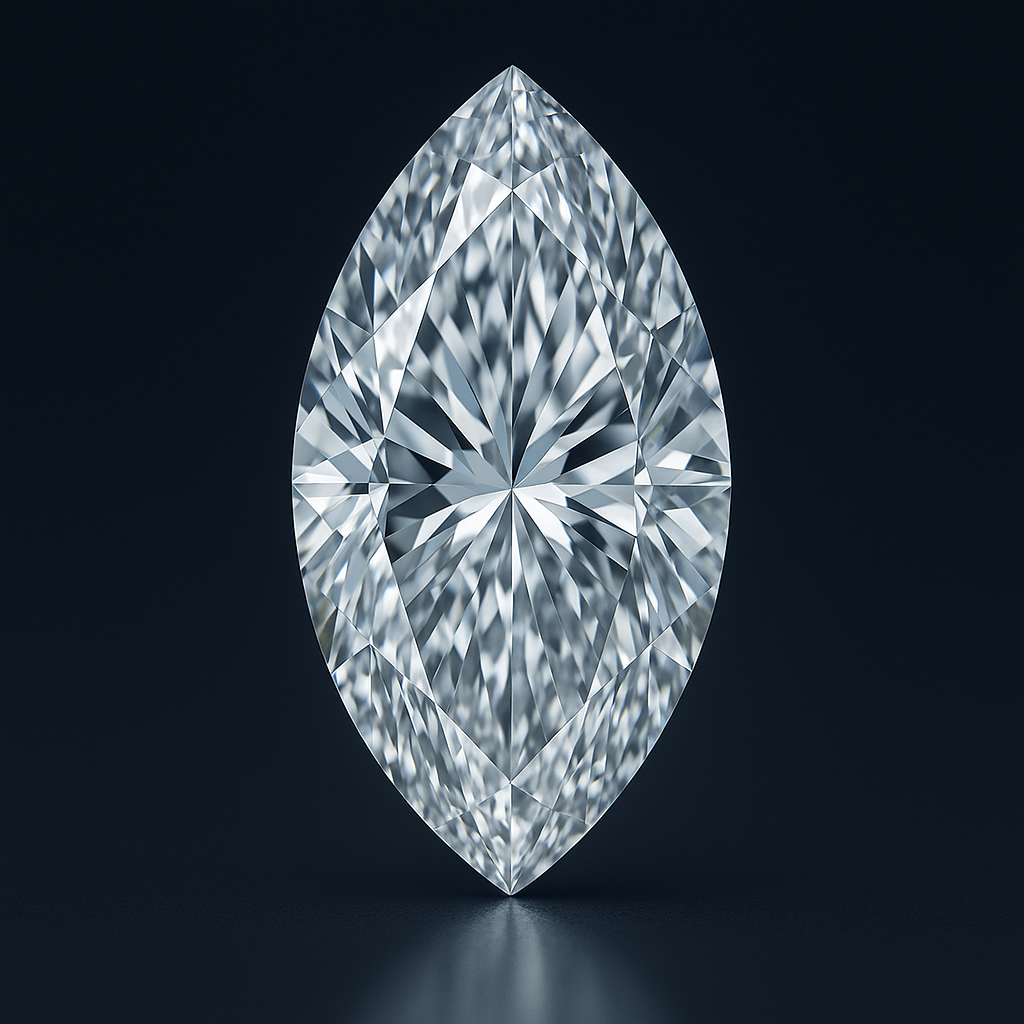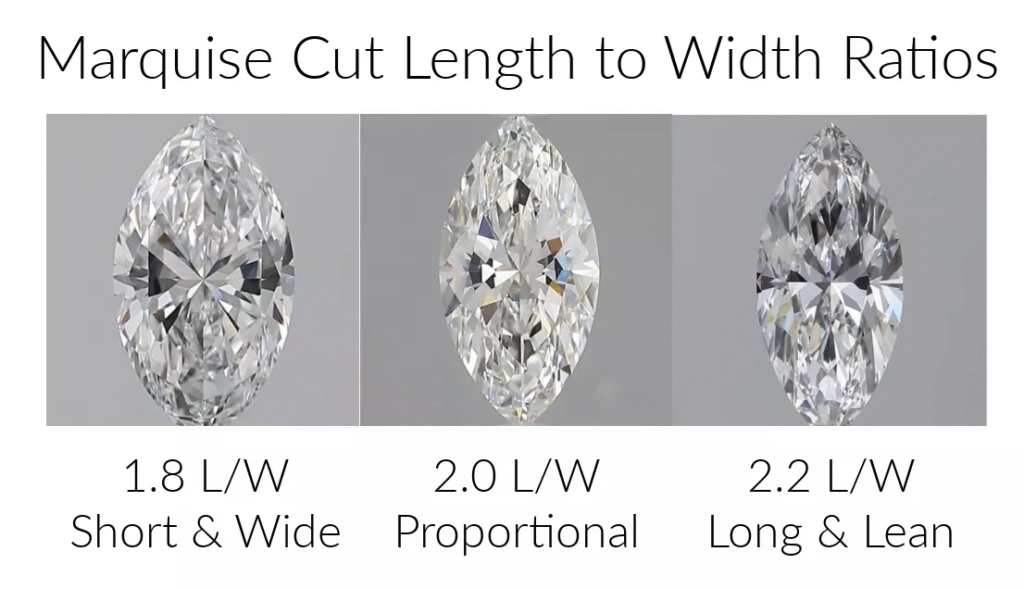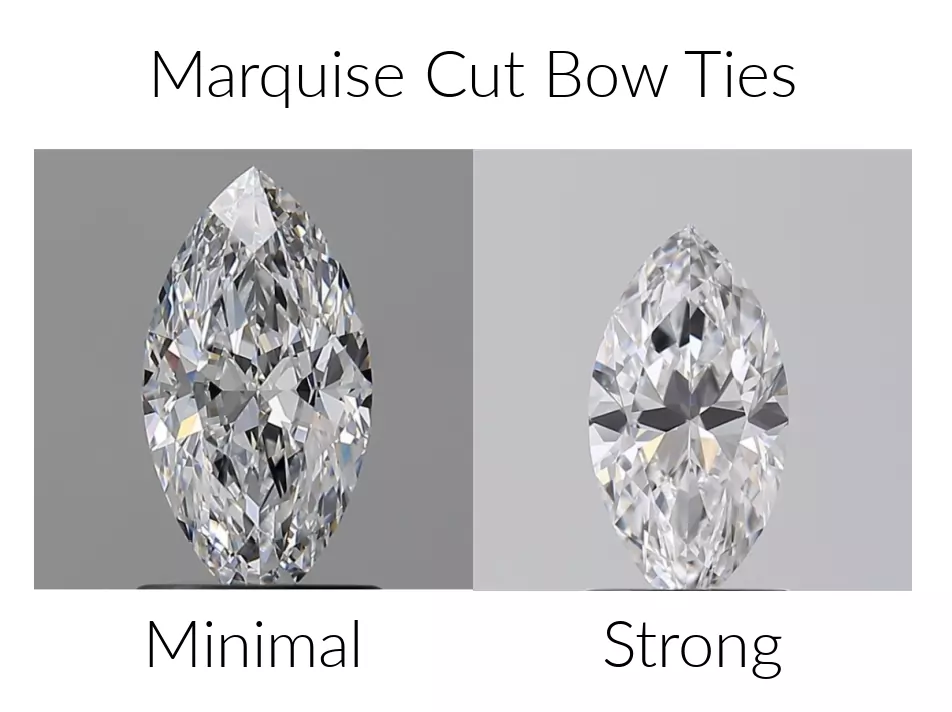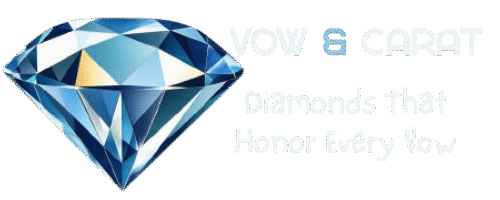Marquise Cut Diamonds: The Complete Guide to Regal Elegance & Bold Sparkle
🌟 Introduction: Why Marquise Diamonds Make a Royal Statement

Long, dramatic, and instantly recognizable, the marquise cut diamond is one of the most elegant and expressive diamond shapes. With its elongated body and pointed ends, the marquise delivers maximum finger coverage, appearing larger than most other shapes of the same carat weight.
Known as the navette cut (“little boat”), the marquise diamond has a fascinating royal history. Legend says it was first commissioned by King Louis XV of France, who wanted a diamond shaped like the lips of his mistress, Madame de Pompadour. Today, the marquise is loved by those who want something unique, bold, and steeped in history.
From Victoria Beckham’s multiple marquise engagement rings to Ashlee Simpson’s Art Deco marquise ring, this diamond continues to make headlines for its striking silhouette.
In this guide, we’ll cover everything you need to know about marquise diamonds: their history, brilliance, the 4Cs, style inspiration, buying strategies, FAQs, myths, and whether they’re the right choice for you.
📜 A Regal History of the Marquise Diamond
🔹 Louis XV’s Commission
The marquise cut dates back to 18th-century France, where King Louis XV ordered jewelers to create a diamond cut that resembled the perfectly shaped lips of his mistress, Madame de Pompadour.
🔹 The Navette Cut
Also known as the navette (French for “little boat”), the marquise shape was elongated, tapered, and pointed at both ends. It became popular among European aristocracy, symbolizing royalty and sophistication.
🔹 20th-Century Resurgence
Marquise diamonds surged in popularity during the Art Deco era of the 1920s–30s, when bold geometric designs dominated jewelry. They re-emerged in the 1970s and 1980s, often in large, dramatic engagement rings.
🔹 Modern Day
Today, the marquise remains less common than rounds or ovals, making it a distinctive choice for buyers seeking individuality and finger-flattering elegance.
💡 Real-World Example: Victoria Beckham has received more than a dozen engagement rings from David Beckham, including a stunning marquise-cut diamond set on a platinum band.
Looking for a Signature Marquise Diamond?
Brian Gavin’s Marquise Cut Diamonds combine elegant elongation with the brand’s signature light performance. Each stone is precision-cut to maximize brilliance while minimizing the bow-tie effect. Ideal for those who want a timeless silhouette with modern sparkle.
💡 What Makes Marquise Diamonds Unique?
Marquise diamonds are distinctive for their elongated shape with pointed ends, offering both sparkle and size advantage.
- Face-Up Size Advantage: Marquises look larger than rounds of the same carat due to their length.
- Finger-Flattering Effect: Their elongated body makes fingers appear slimmer and longer.
- Unique Silhouette: Less common, ensuring a bold and memorable look.
- Brilliance: Cut with brilliant-style facets, they sparkle like rounds and ovals.
- Versatility: Stunning in solitaires, halos, and vintage-inspired settings.
📊 Fun Fact: A 1.0ct marquise diamond can appear 15–20% larger than a 1.0ct round.
🔍 The 4Cs of Marquise Diamonds
1. ✂️ Cut: Symmetry & Bow-Tie Control
Cut quality is critical for marquises.

- Length-to-Width Ratio: 1.75–2.25 is most popular.
- Symmetry: Both ends should align perfectly — asymmetry is noticeable.
- Bow-Tie Effect: Like ovals and pears, marquises can have a dark shadow across the center. Look for stones where it’s subtle.
- Pointed Tips: Must be sharp but well-protected by prongs.
💡 Pro Tip: Poor symmetry can make a marquise look “off-balance” — always check alignment carefully.
2. 🎨 Color: Tips Reveal More Tint
Marquises show color more strongly at the pointed ends.
- Best Value: G–H color in white settings.
- Warm Metals: I–J look lovely in yellow/rose gold.
- Fancy Colors: Marquises are often used for fancy yellows and champagne diamonds, as their elongated shape enhances saturation.
3. 🔍 Clarity: Watch the Center & Tips
Like ovals and pears, marquises hide inclusions well — but tips are vulnerable.
- VS2 or SI1 is often eye-clean.
- Avoid inclusions at tips, where they weaken structure.
- Bow-ties can sometimes disguise inclusions, but evaluate carefully.
4. 💎 Carat: Maximum Coverage for Size
Marquises face up larger than most cuts, offering great size-to-weight value.
- A 1.0ct marquise may look as large as a 1.25–1.30ct round.
- Their elongated shape maximizes finger coverage.
- Larger carats make bold, dramatic statements — a favorite of celebrities.
💡 Example: Ashley Simpson’s marquise engagement ring, though under 3 carats, appears massive on her hand due to the cut’s length.
💍 Marquise Diamonds in Engagement Rings
Marquises are bold, elegant, and adaptable to many settings.
Popular Settings:
- Solitaire: A dramatic centerpiece with maximum finger coverage.
- Halo: Softens the sharp points and enhances sparkle.
- Three-Stone: Marquise center with tapered baguette sides.
- East-West: A horizontal marquise for a modern twist.
Celebrity Inspiration:
- Victoria Beckham → Multiple marquise rings.
- Ashley Simpson → Vintage-inspired marquise halo.
- Portia de Rossi → Marquise engagement ring with halo and twisted band.
🏆 Advantages of Marquise Diamonds
- Appear larger → great face-up spread for carat weight.
- Finger-flattering → elongates and slims the hand.
- Unique silhouette → rare and bold.
- Brilliant sparkle → strong light performance.
- Value for money → often cheaper than rounds.
⚖️ Marquise vs. Other Shapes
| Feature | Marquise Diamond | Round Diamond | Oval Diamond | Pear Diamond |
|---|---|---|---|---|
| Brilliance | ⭐⭐⭐⭐ | ⭐⭐⭐⭐⭐ | ⭐⭐⭐⭐ | ⭐⭐⭐⭐ |
| Face-Up Size | ⭐⭐⭐⭐⭐ | ⭐⭐⭐⭐ | ⭐⭐⭐⭐⭐ | ⭐⭐⭐⭐⭐ |
| Finger-Flattering | ⭐⭐⭐⭐⭐ | ⭐⭐⭐ | ⭐⭐⭐⭐⭐ | ⭐⭐⭐⭐⭐ |
| Price Premium | Medium | High | Medium | Medium |
💰 Pricing & Smart Buying Tips
Marquises are typically 10–25% less expensive than rounds of the same weight.
Tips:
- Look for 1.75–2.25 length-to-width ratio.
- Stick to G–H color for white metals.
- Use V-prongs to protect pointed tips.
- Consider lab-grown marquises for big savings.
🌍 Ethical & Sustainable Marquises
- Lab-Grown Marquises: Affordable, eco-friendly, identical in composition.
- Vintage Marquises: Popular in Art Deco pieces, sustainable, and unique.
- Conflict-Free Diamonds: Certified by the Kimberley Process.
🎯 Advanced Tips
- Skinny Bands: Make marquises appear larger.
- East-West Settings: Trendy and bold alternative orientation.
- Double Halos: Add extra brilliance while protecting tips.
❓ Extended FAQ on Marquise Cut Diamonds
1. Do marquises sparkle like rounds?
Yes — marquises are brilliant-cut gems, so they produce strong sparkle and scintillation. That said, their sparkle isn’t as uniformly distributed as a well-cut round brilliant. Because of the elongated shape and the way light travels through the long facets, marquises can deliver brilliant flashes along the body while sometimes appearing darker in the center. You’ll also see the characteristic “bow-tie” shadow (a darker bow-shaped area) in many marquises; a well-cut stone minimizes that effect and keeps sparkle lively across the table.
2. Do marquises look bigger than other cuts?
Absolutely. Because of their long, narrow profile, marquises have one of the largest face-up areas per carat. A 1-carat marquise will generally look noticeably larger on the finger than a 1-carat round. If you want maximum visual size for your budget, the marquise is a smart choice.
3. What’s the ideal length-to-width ratio?
The sweet spot most buyers like is about 1.75–2.25. Lower ratios (≈1.5–1.7) give a plumper, almost oval appearance; higher ratios (2.3+) look very long and dramatic. Pick a ratio to match the look you want: classical elegance (~1.8–2.0) or dramatic elongation (>2.0). Also remember body proportions of the wearer — very long marquises can make short fingers look smaller; a modest elongation tends to flatter most hands.
4. Do marquises chip easily?
The pointed tips are the vulnerable parts. They aren’t fragile in normal wear, but they are more exposed than a round’s girdle. Good protection matters: strong prongs (V-prongs or bezel tips) and a secure setting reduce the risk. Avoid settings that leave the tips naked if the wearer is active or uses hands a lot.
5. What clarity grade is best?
VS2 and SI1 often offer the best value. Because of the marquise’s faceting and slender shape, many inclusions fall near the edges or are masked by facet reflections. VS2 typically appears clean to the unaided eye; SI1 can also be eye-clean if inclusions are positioned near the points or under prongs. If you want absolute peace of mind, aim for VS1 or better — but for smart budgeting, VS2–SI1 is where value meets appearance.
6. Do marquises show color more?
Yes — especially near the pointed ends. Because the table can be relatively large and the pavilion long, color can be more noticeable than in rounds. If you’re sensitive to warmth, choose G–H for near-colorless that still feels white, or D–F if you want the purest icy look. The setting metal matters too: yellow gold hides warmth; platinum or white gold makes the diamond look whiter.
7. Are marquises vintage or modern?
Both. The shape goes way back — credited to Louis XV’s court in the 18th century — so it carries vintage pedigree. At the same time, it’s been reinterpreted across eras: Art Deco elongations, midcentury accents, and very modern thin halos and east-west mounts. That versatility explains why marquises feel both nostalgic and current.
8. Do marquises flatter all hands?
Yes, generally. The elongated silhouette visually lengthens and slims fingers, so marquises are especially flattering on shorter or wider fingers. Very long marquises can look dramatic on slender fingers, but proportion matters — choose a length that complements the wearer’s hand rather than overwhelming it.
9. Are lab-grown marquises real?
Yes. Lab-grown diamonds are chemically, physically, and optically the same as mined diamonds. A lab-grown marquise will display the same fire, scintillation, and durability — and usually at a lower price point. The main differences are origin and resale/market dynamics, not performance.
10. Do marquises cost less than rounds?
Typically, yes. Marquises generally run about 10–25% cheaper than comparable round brilliants per carat, because rounds are the market’s most popular and mechanically expensive cut. Exact pricing depends on cut quality, color, and clarity, but marquises are a good route to a larger-looking stone for the same budget.
11. Do marquises show bow-ties?
Yes — almost every marquise will show some bow-tie effect. The goal when buying is to choose a cut that minimizes the bow-tie so it doesn’t dominate the face. Look at multiple photos (or videos) from different angles: a subtle bow-tie is normal and acceptable; a strong dark bow-tie that disrupts the table is a sign to keep looking.

12. What settings work best?
Marquises play well in many settings:
- Solitaire — clean, shows the shape.
- Halo — enlarges face-up appearance and hides color.
- Three-stone — classic, balances the length with side stones.
- East-west (horizontal) — modern, eye-catching.
Tip protection like V-prongs or partial bezels is recommended to guard the points. Halos and side stones also add structural support and visual weight.
13. Do marquises look good horizontally?
Yes. East-west marquise rings are trendy and feel fresh: they shorten perceived length while keeping that elegant silhouette. This orientation can be more subtle on the hand and suits people who prefer something less traditional.
14. Are marquises trendy or timeless?
Timeless with recurring waves of trendiness. The cut has centuries of history, which gives it classic gravitas, but designers keep reimagining it, so it also reads as fashion-forward when styled differently. In short: it’s a classic that never fully goes away.
15. Do marquises hold resale value?
Not as universally strong as rounds, which are the easiest to resell. Rounds dominate the market and retain liquidity. That said, marquises can still have good resale value — particularly rare, high-quality stones or distinctive vintage pieces that attract collectors. Market demand, brand, and how fashionable the cut is at the time all affect resale. If resale is a priority, buy the best cut and color you can afford and keep documentation.
🔮 Myths & Misconceptions
- Myth 1: Marquises are outdated.
Reality: They’ve been loved for centuries and remain fashionable today. - Myth 2: All marquises have ugly bow-ties.
Reality: High-quality cuts minimize bow-ties significantly. - Myth 3: Marquises are fragile.
Reality: Only the tips are delicate — protective settings solve this.
📌 Conclusion: Is a Marquise Diamond Right for You?
If you want a diamond that is:
✔ Regal and distinctive
✔ Larger-looking for its carat weight
✔ Flattering and elegant on the finger
✔ Steeped in royal history
…then the marquise cut diamond is a perfect choice.
With its bold silhouette, flattering proportions, and fascinating history, the marquise remains one of the most expressive and romantic cuts in the diamond world.
